-
 Bitcoin
Bitcoin $107,443.3008
-1.17% -
 Ethereum
Ethereum $2,494.2503
-0.63% -
 Tether USDt
Tether USDt $1.0003
0.00% -
 XRP
XRP $2.2496
2.23% -
 BNB
BNB $658.7569
0.63% -
 Solana
Solana $154.9826
1.94% -
 USDC
USDC $1.0000
0.01% -
 TRON
TRON $0.2799
1.07% -
 Dogecoin
Dogecoin $0.1659
-1.78% -
 Cardano
Cardano $0.5745
0.25% -
 Hyperliquid
Hyperliquid $39.7005
0.13% -
 Bitcoin Cash
Bitcoin Cash $519.5989
3.78% -
 Sui
Sui $2.7874
-2.40% -
 Chainlink
Chainlink $13.3762
-1.69% -
 UNUS SED LEO
UNUS SED LEO $9.0784
-0.64% -
 Avalanche
Avalanche $17.9846
-2.81% -
 Stellar
Stellar $0.2390
-0.06% -
 Toncoin
Toncoin $2.9028
0.25% -
 Shiba Inu
Shiba Inu $0.0...01147
-2.17% -
 Litecoin
Litecoin $86.6956
-1.27% -
 Hedera
Hedera $0.1508
-0.50% -
 Monero
Monero $322.6222
3.26% -
 Polkadot
Polkadot $3.4124
-2.99% -
 Dai
Dai $0.9999
0.00% -
 Bitget Token
Bitget Token $4.5434
-1.97% -
 Ethena USDe
Ethena USDe $1.0002
0.00% -
 Uniswap
Uniswap $7.1562
-2.61% -
 Aave
Aave $275.8830
-1.02% -
 Pepe
Pepe $0.0...09790
-4.04% -
 Pi
Pi $0.5018
-5.09%
Is the monthly RSI oversold + weekly moving average turning a long-term entry signal?
A monthly RSI below 30 combined with a weekly moving average crossover can signal strong long-term crypto entry points.
Jun 30, 2025 at 11:42 pm
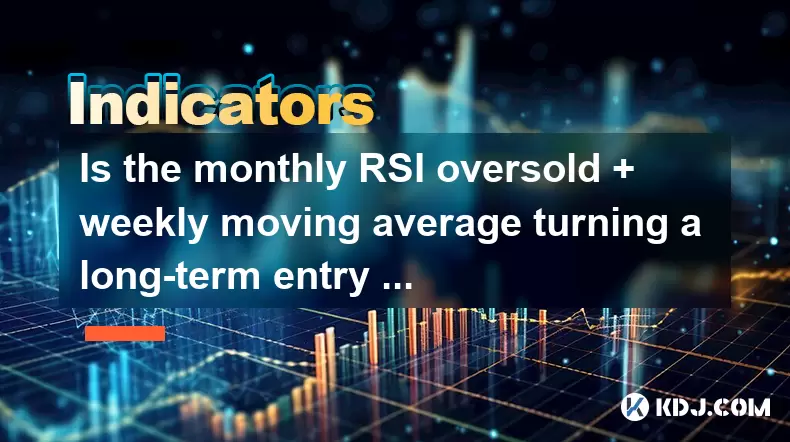
Understanding RSI and Its Role in Cryptocurrency Trading
The Relative Strength Index (RSI) is a momentum oscillator commonly used by traders to identify overbought or oversold conditions in the market. In the context of cryptocurrency, where volatility reigns supreme, understanding how RSI behaves on different timeframes becomes crucial. When the monthly RSI dips into oversold territory (typically below 30), it may signal that the asset has been excessively sold off over an extended period.
This long-term perspective helps filter out short-term noise and provides insight into broader market sentiment. However, relying solely on RSI can be misleading due to the crypto market's tendency to stay in overextended zones for prolonged periods. Therefore, combining this signal with other technical tools like moving averages enhances its reliability.
The Significance of Weekly Moving Averages in Trend Confirmation
Moving averages are essential for confirming trends and potential reversals. The weekly moving average, especially when using longer-period indicators such as the 50-week or 200-week moving average, offers a clearer picture of the prevailing trend. When price action begins to stabilize above these key levels after a downtrend, it often signals a shift in market psychology.
A moving average turning point occurs when the slope changes from downward to upward or when the price crosses above the moving average decisively. This dynamic support level can act as a catalyst for new buying pressure, particularly if aligned with favorable RSI readings on higher timeframes.
Combining Monthly RSI Oversold Conditions with Weekly Moving Average Crossovers
When the monthly RSI enters oversold territory and simultaneously the weekly moving average turns bullish, it creates a compelling confluence for potential long-term entry opportunities. This combination filters out false signals and increases the probability of catching a significant reversal.
Traders should look for:
- Monthly RSI dropping below 30 and showing signs of divergence
- Weekly price crossing above key moving averages (e.g., 50 or 200)
- Volume confirmation during the crossover phase
This alignment suggests that institutional players might be stepping in after a deep correction, potentially setting the stage for a new uptrend cycle.
Practical Steps to Identify and Confirm the Signal
To effectively apply this strategy, follow these steps:
- Monitor monthly RSI levels regularly and note when it drops below 30
- Plot weekly moving averages on your charting platform—preferably both 50 and 200
- Look for crossovers between price and moving averages on the weekly timeframe
- Check volume patterns during the crossover to confirm institutional participation
- Observe candlestick formations around the moving average zone for additional confirmation
Each step must be executed with precision. For example, a monthly RSI bounce from oversold without a corresponding weekly moving average flip may not provide a reliable setup. Conversely, a moving average crossover without oversold RSI may indicate a continuation rather than a reversal.
Historical Examples in Cryptocurrency Markets
In previous Bitcoin cycles, notable bottoms have occurred when the monthly RSI reached extreme lows while the weekly moving averages began to flatten or turn upwards. For instance, during the 2018–2019 bear market bottom, BTC/USD saw the monthly RSI drop below 25, followed by a clear weekly breakout above the 200-week MA.
Ethereum also exhibited similar behavior during major corrections, where a confluence of RSI and moving average signals preceded substantial rallies. These examples highlight the importance of aligning multiple timeframes to increase the robustness of trade setups.
Common Pitfalls and How to Avoid Them
One of the most common mistakes traders make is acting on early signals before they fully materialize. Just because the monthly RSI is oversold doesn't guarantee an immediate reversal. Similarly, a weekly moving average touch without a confirmed breakout can lead to premature entries.
Avoid these pitfalls by:
- Waiting for clear candle closes above the moving average
- Confirming RSI divergence through higher highs on the RSI line despite lower lows in price
- Using secondary indicators like MACD or On-Balance Volume (OBV) for added validation
Patience and discipline are vital when trading long-term signals. Rushing into a position based on incomplete data often leads to unnecessary losses.
Frequently Asked Questions
What does it mean when the monthly RSI is oversold?
It indicates that the asset has experienced strong selling pressure over the past month. While not always a direct buy signal, it highlights potential exhaustion among sellers and sets the stage for possible trend reversal scenarios.
How do I know if the weekly moving average is turning bullish?
Look for a change in the slope of the moving average from descending to flat or ascending. Additionally, observe whether the price consistently holds above the moving average over several weeks and whether volume supports this move.
Can this strategy be applied to altcoins?
Yes, but with caution. Larger-cap cryptocurrencies tend to respect technical indicators more reliably than smaller ones. Always verify historical behavior and ensure sufficient liquidity before applying the same logic to lesser-known tokens.
Is there a specific RSI setting preferred for monthly charts?
Most traders use the standard 14-period RSI on the monthly chart. Some prefer smoothing it further with Wilder’s smoothing method or increasing the period to 21 for reduced sensitivity. The goal remains consistent: identifying extreme conditions across long-term cycles.
Disclaimer:info@kdj.com
The information provided is not trading advice. kdj.com does not assume any responsibility for any investments made based on the information provided in this article. Cryptocurrencies are highly volatile and it is highly recommended that you invest with caution after thorough research!
If you believe that the content used on this website infringes your copyright, please contact us immediately (info@kdj.com) and we will delete it promptly.
- Circle, Stablecoins, and National Banks: A New Era for Digital Finance?
- 2025-07-01 09:10:12
- Stablecoin Showdown: USD1 vs. USDC and the Regulatory Rumble
- 2025-07-01 09:10:12
- Qubetics, Crypto Investment, Hedera & Avalanche: Navigating the July 2025 Crypto Landscape
- 2025-07-01 08:50:12
- Kazakhstan's Crypto Reserve: Balancing Financial Stability and Digital Innovation
- 2025-07-01 09:15:11
- Ruvi AI: The 13,800% Bull Run Return That Could Outshine Tron
- 2025-07-01 09:20:12
- Ethereum, Cardano, SUI & OP: Navigating the Shifting Crypto Landscape
- 2025-07-01 08:50:12
Related knowledge
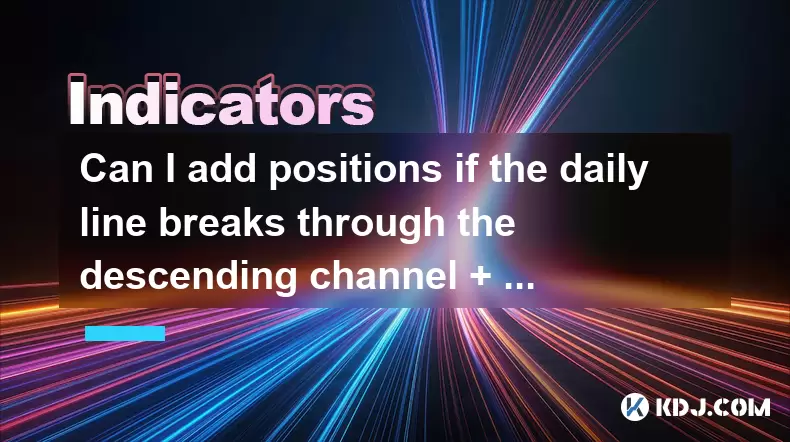
Can I add positions if the daily line breaks through the descending channel + the 30-minute moving average is in a bullish arrangement?
Jun 30,2025 at 11:00pm
Understanding the Descending Channel BreakoutWhen a daily line breaks through a descending channel, it indicates a potential shift in market sentiment from bearish to bullish. A descending channel is formed by drawing two parallel trendlines, where the upper trendline connects the lower highs and the lower trendline connects the lower lows. A breakout o...
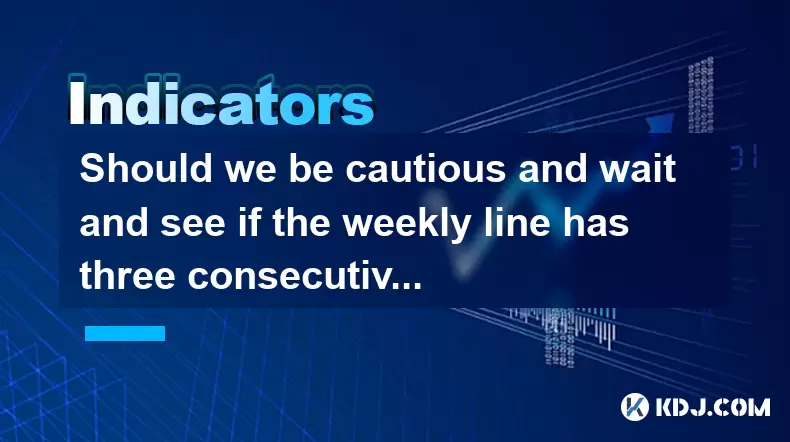
Should we be cautious and wait and see if the weekly line has three consecutive Yin lines + the daily MACD green column enlarges?
Jul 01,2025 at 12:42am
Understanding the Weekly Three Consecutive Yin Lines PatternIn technical analysis, three consecutive Yin lines on a weekly chart indicate a strong bearish trend. Each Yin line represents a week where the closing price is lower than the opening price, signaling consistent selling pressure. When this pattern appears three times in succession, it often sug...
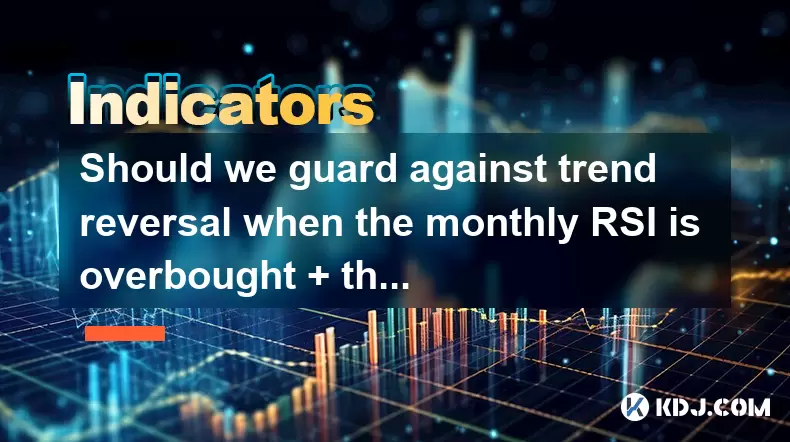
Should we guard against trend reversal when the monthly RSI is overbought + the weekly line has a long upper shadow?
Jun 30,2025 at 11:35pm
Understanding RSI Overbought Conditions in CryptocurrencyThe Relative Strength Index (RSI) is a momentum oscillator commonly used in technical analysis to identify overbought or oversold conditions in an asset. When the monthly RSI of a cryptocurrency reaches above 70, it is generally considered overbought, suggesting that the asset may be due for a pul...
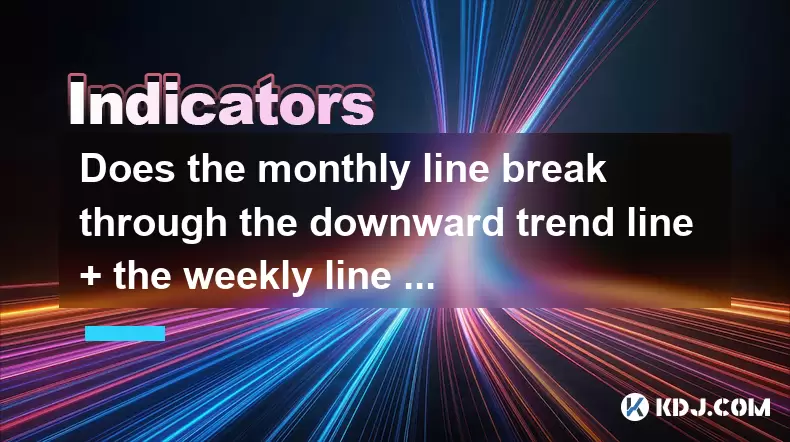
Does the monthly line break through the downward trend line + the weekly line with large volume confirm the reversal?
Jul 01,2025 at 04:49am
Understanding the Monthly Line Breakthrough in CryptocurrencyIn cryptocurrency trading, a monthly line refers to the price movement over a 30-day period represented on a candlestick chart. When this monthly line breaks through a downward trend line, it suggests that the long-term bearish momentum might be weakening. A downward trend line is drawn by con...
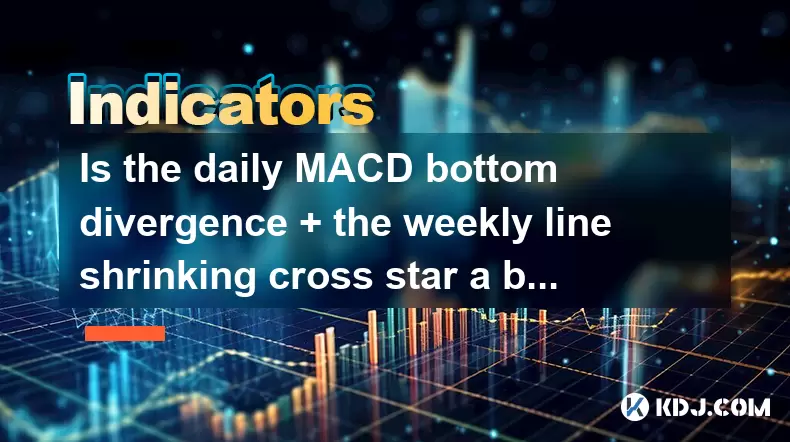
Is the daily MACD bottom divergence + the weekly line shrinking cross star a bottoming signal?
Jul 01,2025 at 03:49am
Understanding MACD Bottom Divergence in Cryptocurrency TradingThe Moving Average Convergence Divergence (MACD) is a widely used technical indicator among cryptocurrency traders to identify potential trend reversals. A bottom divergence occurs when the price of an asset makes a lower low, but the MACD line forms a higher low. This suggests that bearish m...
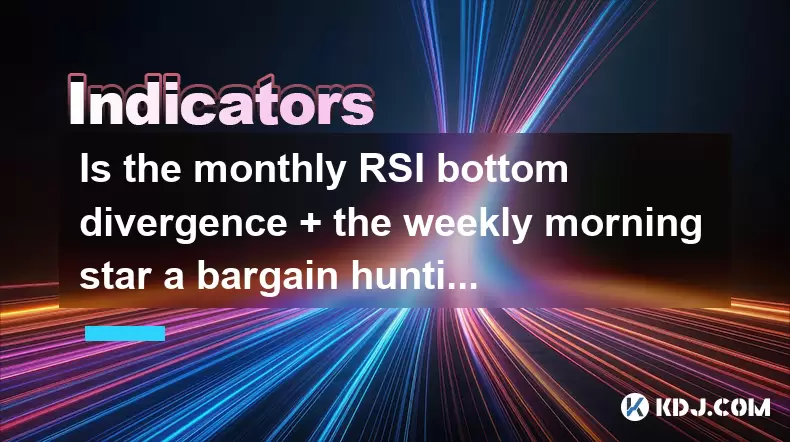
Is the monthly RSI bottom divergence + the weekly morning star a bargain hunting opportunity?
Jun 30,2025 at 09:57pm
Understanding RSI Bottom Divergence in Monthly TimeframesThe Relative Strength Index (RSI) is a momentum oscillator commonly used to identify overbought or oversold conditions in the market. When traders refer to a monthly RSI bottom divergence, they're observing a situation where the price makes a lower low, but the RSI makes a higher low on the monthl...

Can I add positions if the daily line breaks through the descending channel + the 30-minute moving average is in a bullish arrangement?
Jun 30,2025 at 11:00pm
Understanding the Descending Channel BreakoutWhen a daily line breaks through a descending channel, it indicates a potential shift in market sentiment from bearish to bullish. A descending channel is formed by drawing two parallel trendlines, where the upper trendline connects the lower highs and the lower trendline connects the lower lows. A breakout o...

Should we be cautious and wait and see if the weekly line has three consecutive Yin lines + the daily MACD green column enlarges?
Jul 01,2025 at 12:42am
Understanding the Weekly Three Consecutive Yin Lines PatternIn technical analysis, three consecutive Yin lines on a weekly chart indicate a strong bearish trend. Each Yin line represents a week where the closing price is lower than the opening price, signaling consistent selling pressure. When this pattern appears three times in succession, it often sug...

Should we guard against trend reversal when the monthly RSI is overbought + the weekly line has a long upper shadow?
Jun 30,2025 at 11:35pm
Understanding RSI Overbought Conditions in CryptocurrencyThe Relative Strength Index (RSI) is a momentum oscillator commonly used in technical analysis to identify overbought or oversold conditions in an asset. When the monthly RSI of a cryptocurrency reaches above 70, it is generally considered overbought, suggesting that the asset may be due for a pul...

Does the monthly line break through the downward trend line + the weekly line with large volume confirm the reversal?
Jul 01,2025 at 04:49am
Understanding the Monthly Line Breakthrough in CryptocurrencyIn cryptocurrency trading, a monthly line refers to the price movement over a 30-day period represented on a candlestick chart. When this monthly line breaks through a downward trend line, it suggests that the long-term bearish momentum might be weakening. A downward trend line is drawn by con...

Is the daily MACD bottom divergence + the weekly line shrinking cross star a bottoming signal?
Jul 01,2025 at 03:49am
Understanding MACD Bottom Divergence in Cryptocurrency TradingThe Moving Average Convergence Divergence (MACD) is a widely used technical indicator among cryptocurrency traders to identify potential trend reversals. A bottom divergence occurs when the price of an asset makes a lower low, but the MACD line forms a higher low. This suggests that bearish m...

Is the monthly RSI bottom divergence + the weekly morning star a bargain hunting opportunity?
Jun 30,2025 at 09:57pm
Understanding RSI Bottom Divergence in Monthly TimeframesThe Relative Strength Index (RSI) is a momentum oscillator commonly used to identify overbought or oversold conditions in the market. When traders refer to a monthly RSI bottom divergence, they're observing a situation where the price makes a lower low, but the RSI makes a higher low on the monthl...
See all articles

























































































